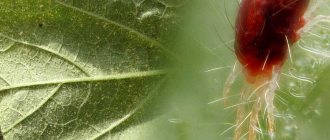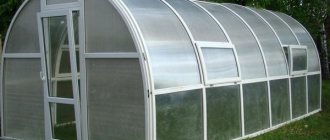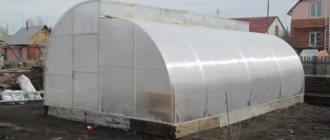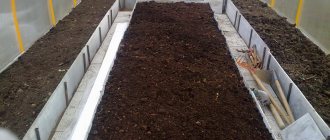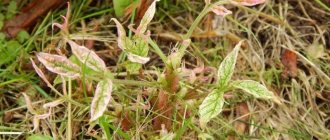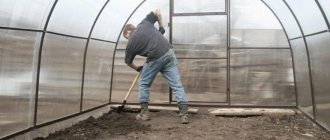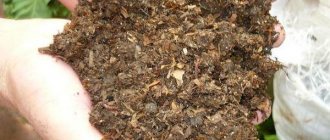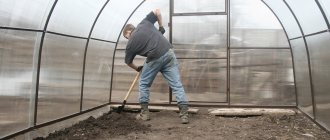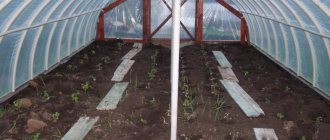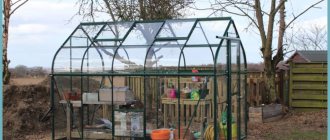Late blight is an insidious enemy of all nightshade crops, including tomatoes, peppers, potatoes and eggplants. This disease manifests itself in the form of dark brown spots covering the stems and fruits, from which the active process of rotting begins. All this cannot but cause concern for any summer resident. The cause is spores of fungus-like microorganisms. In a greenhouse or greenhouse, infection occurs especially quickly, therefore, if there is a reasonable fear that this enemy may break through under the constructed shelter, it is necessary to take preventive measures in advance.
Prevention is the main key to protecting crops planted in a greenhouse, since fighting late blight is an extremely difficult task. The spores of this microorganism are very tenacious, so you cannot be sure that under the influence of frost they will be destroyed throughout the entire area of the soil. For this reason, if there is a high probability of infection of greenhouse plants, which may be indicated by the outbreak of this disease on crops inside or outside the greenhouse structure last year, it is necessary to figure out how to treat the greenhouse against late blight in the spring.
Late blight on tomatoes
Obvious danger
The question of how to deal with late blight is asked by every serious gardener, because simply planting bushes is not enough, you need to provide watering, weed control and protection from diseases.
The danger is very great; if you do not act or leave the possibility of a problem without proper attention, the fungus will definitely spoil the harvest. The following crops are often susceptible to harmful effects:
- Tomatoes.
- Pepper.
- Eggplant.
In plants that are affected by the disease, a white coating appears, gradually from the underside of the leaf it moves to the stem and covers the fruit.
Experts consider the main difference to be the appearance of dark brown wet spots. The crop rots quite quickly if proper care is not provided, and neighboring plantings will also be in danger.
Preventive measures
To reduce the occurrence of late blight on the site, it is advisable to use the prevention of this disease:
- Correct landing. Tomatoes should not be planted in the place where potatoes, peppers, and eggplants previously grew, and these crops should not be located nearby. An ideal place for tomatoes is the bed where cucumbers, beets, onions, etc. previously grew. It is best to plant tomatoes in a new location every year.
- It is recommended to dilute soil with a high lime content with peat (it is added to the planting hole), and after planting, a small amount of sand is poured next to the bushes.
- Tomatoes need to be planted maintaining the distance between the bushes and avoiding thickening of the plantings.
- Watering should be at the roots, water should not get on the foliage and tomatoes. It is important not to forget about loosening the soil layer next to the bushes.
- Carrying out mulching.
- It is recommended to plant white mustard, calendula, marigolds, garlic and onions near tomatoes.
- Timely pinching and cutting off unnecessary leaves.
- Applying potassium and phosphorus fertilizers, spraying with immunostimulating substances to enhance the plant’s immune system.
- Regular ventilation of the greenhouse.
- Application of nitrogen fertilizers in the first half of the growing season, then excess nitrogen can provoke the appearance of late blight.
Following these simple rules will prevent tomatoes from becoming infected with a dangerous disease. Every gardener must remember that it is easier to prevent any illness than to treat it later.
Processing of main parts
Before moving on to choosing products and deciding how to treat the greenhouse against late blight, it is necessary to carry out a number of preparatory work. This includes clearing out all excess debris in the fall. Of the undesirable plant components, it is worth highlighting:
- Tops.
- Root system.
- Spoiled fruits.
- Weed.
As soon as this stage is completed, you need to move on to disassembling all removable parts; it is better to take them outside. To treat the walls, a special solution is used; it is prepared using finely chopped laundry soap and water; about 40-50 grams of shavings are required for 10 liters of liquid.
The room must dry; for this, windows and doors are left open for a certain period of time, after which it is worth using one of the methods for complete disinfection.
Prevention
Most oomycete spores are found in the ground. In autumn and spring, the main preventive measures are digging up the soil, removing plant debris and disinfecting it. Let's consider what can be used for preventive soil disinfection. This is most often:
- a strong solution of potassium permanganate (it is a powerful antiseptic and, in combination with hot water, kills overwintering fungal spores);
- copper-containing preparations (only for early spring application during the first plowing of the land);
- biological product Fitosporin-M (the solution is prepared in water at a temperature of no more than 35 °C, so that diseased bacteria do not die. The drug is allowed to infuse for 1-2 hours).
Fungal spores reach plants with rising air currents from the heated soil. To prevent this, it is recommended to mulch the top layer of soil immediately after digging it in the spring.
Lime base
This type of chemical action on the fungus is effective enough to get rid of late blight; the greenhouse is treated after thorough washing and drying with a rag.
The mixture can be prepared according to a specially developed and tested recipe for 10 liters. liquid, you need to add 1 kg of product. Infusion plays a special role, after which the concentrated water should be filtered.
Important! You should be careful when performing manipulations; chlorine vapors can harm human health; it is better to use a respirator and gloves.
The room must be left to settle; three days will be enough for the fungus to be completely destroyed and not affect the plantings.
After which the building is ventilated, to consolidate the result, the wooden components are washed with a solution made from copper sulfate with a concentration of 5-10%.
Signs of late blight (late blight) on tomatoes
Unfortunately, often due to the inattention, sometimes even carelessness of the owners, precious time is lost and emergency measures have to be taken, often not entirely useful and safe.
Novice gardeners often don’t know what late blight looks like on tomatoes, so they don’t sound the alarm. At the first stage of infection, yellowing and drying of the foliage is observed, mainly in the lower part of the plant. Later, the leaves die off. The fungus will not stop there and quickly attacks the fruits, causing them to turn black.
| Note. Advanced gardeners with many years of experience have learned to detect the approach of the “enemy” in advance, since it happens at approximately the same time. In the Far Eastern Federal District, the most severe outbreaks of infection in open ground occur quite late - in August–September. In a greenhouse, favorable conditions can develop much earlier. Especially if there are potato plantings nearby, even outside the greenhouse, which are the primary source of infection. |
After the first manifestations on potatoes, wait 10–12 days for a “guest” on your tomatoes. This gives you an understanding of when to treat tomatoes against late blight (late blight) in a greenhouse: as soon as the first ovaries appear, it’s time to be wary and start preventative spraying and watering. 2–3 such treatments can be carried out at intervals of 2–3 weeks. Now you need to regularly carefully examine your plants so as not to miss the first signs, when you can still help with less toxic or folk remedies.
| Recommendation. Change the treatment agents periodically, otherwise the fungus adapts to one drug and stops responding to it. In this case, all your efforts will be in vain. |
Photo pixabay/Dustytoes: The disease requires prompt help from the gardener to the plants.
Fungicide help
A similar no less effective method is perfect for treating a polycarbonate greenhouse against late blight, but you need to choose a chemical product, then this liquid will also saturate the substrate.
The presence of dangerous components in the composition requires compliance with safety rules, which can be found by carefully reading the instructions for use. It is worth highlighting several of the most common names of fungicides:
- Virocide.
- Oksikhom.
- Abiga-pik.
Spraying is carried out in the morning or evening, but you need to create a suitable temperature in the room; experts believe that the optimal indicators will be 10-25 degrees.
Treatment with chemicals
Chemicals are highly effective and are usually used when signs of the disease appear. Their disadvantage is toxicity and the ability to accumulate in soil and fruits.
Fitosporin
This is a biofungicide with antifungal and antibacterial effects. The drug contains Bacillus subtilis, a natural enemy of the pathogen late blight.
Effect of using Fitosporin:
- inhibits the spread of late blight;
- helps improve soil condition;
- the treated leaves and shoots are covered with a protective film that prevents damage by bacteria and fungi.
The drug can be used at different stages - during seed treatment, when transplanting seedlings, during the period of damage. Fitosporin solution is used to treat not only tomato plantations, but also the soil in tomato rows, garden tools, and dry tops collected for placement in a compost pit.
How to use Fitosporin:
- after the first treatment, repeat spraying is carried out - about a week later;
- It is recommended to water the soil with Fitosporin solution once a month;
- For prevention, foliage is sprayed if unfavorable weather conditions arise.
Dosage for spraying – 3 tsp. on a bucket of water. For better adhesion, it is recommended to add 1 tbsp to the solution. l. liquid soap.
Hom
The drug HOM is a fungicide based on copper oxychloride. It is a light green powdery product that is insoluble in water. HOM is part of many combined fungicides - Ordan, Kuprolux, Homoxil and others.
The drug has a preventive and protective effect. It protects plants from fungus from the moment spores germinate until the symptoms of late blight appear. If signs of disease appear on the bushes, spraying with HOM will no longer be enough; a systemic fungicide is additionally needed.
Features of using HOM:
- The drug is effective until the disease appears. If the leaves begin to turn brown, it is too late to apply HOM.
- It is allowed to use HOM no more than 4 times during the season.
- An interval of 10 days should be observed between sprayings. This frequency is justified when there is a high risk of infection and during rainy summers.
How to prepare and use HOM solution:
- Dilute 40 g of dry drug or 50 g of suspension in 1 liter of water.
- Mix thoroughly and bring the volume to 10 liters.
- Spray the bushes with the prepared mixture - 1-1.5 liters for every 10 square meters. m of tomato plantation.
- You need to spray the leaves not only from above, but also from below.
The HOM solution should not flow from the bushes into the soil. This can trigger the suppression of beneficial soil fauna, such as earthworms.
HOM is cheap, non-phytotoxic and does not accumulate in fruits and soil. The disadvantages of the drug include a short period of protection, washing off by rain and a large amount of solution that must be prepared for treatment. HOM provokes corrosion of metal products.
Ordan
The powdered domestic drug Ordan is used for the treatment and prevention of late blight and other fungal diseases. Contains copper oxychloride and cymoxanil. The first component has an external effect, the second - internal.
Ordan inhibits and destroys various pathogens, heals infected areas, and has a complex effect. Pathogens do not have resistance to this drug. Ordan is low toxic and is completely removed from the soil during the season.
Features of using Ordan:
- the drug is used at all stages of tomato development, except flowering - so as not to poison the bees;
- the treatment is not carried out in sunny weather so as not to cause burns;
- It is prohibited to treat wet plants;
- the maximum number of sprayings per season is 2-3;
- Consumption rate in open ground is 80 ml of working solution per 1 sq. m.
How to prepare and use Ordan's solution:
- Dilute 50 g of powder in a bucket of water.
- Spray the leaves and stems on the day you prepare the solution.
Ridomil Gold
This systemic contact fungicide is made in Switzerland. Contains two active ingredients - mancozeb and mefenoxam, respectively, for external and internal protection. The drug affects a wide range of pathogens and does not allow relapses. It is effective in advanced stages, does not burn, does not freeze, and does not precipitate.
Cons of Ridomil Gold:
- expensive;
- toxic;
- high consumption per 1 sq. m;
- accumulates in the ground;
- kills beneficial fungi in the soil.
How to prepare and use the solution:
- Dilute 50 g of powder in 5 liters of water.
- Mix thoroughly.
- Add up to 10 liters and spray the beds in the morning - if there is no dew, or in the evening.
- Use the prepared solution within 2-3 hours.
Thanos
Thanos is a contact-systemic fungicide intended for the prevention and treatment of fungal diseases. Contains two active ingredients - cymoxanil and famoxadone. The first substance has a triple effect - it treats, prevents and protects, the second - kills fungal spores.
Water-soluble granules do not freeze or crystallize, do not generate dust and are perfectly soluble in water. The drug has a wide spectrum of action, in addition to late blight, it saves tomatoes from phomosis, mildew, various rots and other diseases.
Advantages of Thanos:
- combined action;
- does not accumulate in fruits and soil;
- economical;
- fast-acting;
- convenient release form.
Thanos has no flaws. The main thing is to follow the dosage and act according to the instructions.
How to prepare the solution:
- dissolve the drug according to the dosage indicated on the package;
- Pour the mixture into the sprayer tank and add water.
The protection is effective for two weeks. During the season, the drug is used up to 4 times. The minimum intervals between treatments are 15 days. The first spraying is recommended 2 weeks after planting the seedlings.
Grandfather's way
A sulfur block is used to treat the greenhouse against late blight in the spring; to carry out the manipulations, lump sulfur should be purchased. The detailed algorithm of actions looks like this:
- Place the pieces on a metal plate, having previously distributed them into 100 grams.
- Water with kerosene.
- The substance is set on fire.
- The premises are closed for 4-5 days.
Before starting work, you should prepare and put on a protective suit, gloves and a respirator. Combustion products are toxic, so professionals advise purchasing glasses; after smoke gets into your eyes, they will begin to water.
For every 2 meters of area you will need to install one tray, constructed from a plate or sheet of metal at your personal discretion.
Thermal type impact
There are tomatoes for greenhouses that are resistant to late blight, but experienced gardeners do not take risks and carry out preventive measures without relying on such information.
To implement this method, you need to create a certain temperature regime, frying or freezing. Manipulations are often carried out in the fall; it is better to choose a dry day.
To destroy the pathogenic fungus, you should tightly seal the room, close all the cracks and raise the temperature to 30 degrees; the spores will become inactive, and when raised to 35 degrees they will completely die.
To carry out freezing, you should choose a cold day; not all regions of the country can boast of such indicators, so the method is used by a limited number of gardeners.
Reasons for the appearance and conditions for the development of late blight on tomatoes in a greenhouse
The rate of spread of infection (primarily in the greenhouse) depends on temperature and humidity. If treatment measures are not taken urgently, you can lose up to 75% or more of the crop. In protected soil conditions, infection occurs much faster than in garden beds. It is less common in glass greenhouses and causes less harm.
| Reference. Late blight affects not only fruits at any stage of ripeness, but also the entire bush. |
Conditions under which late blight is most likely to develop:
- Temperature changes day and night.
- Failure to comply with the required temperature conditions in the greenhouse.
- Excessively dense plantings.
- Lack of timely ventilation.
- High humidity.
- Damp cloudy weather.
- Weakened plants.
- High content of lime, used to deoxidize the soil in the greenhouse.
- Poorly prepared greenhouse since autumn, lack of disinfection of the greenhouse structure and soil.
- Weeds and plant debris - places where infectious agents accumulate - have not been removed.
Fungal spores persist for a long time in plant debris, soil, and seeds. They may not show themselves for a long time, waiting for favorable conditions. And as soon as this happens, the fungus begins its harmful activities. And the main thing here is not to waste time and start fighting for the harvest. As in any other case of infection, it is better to prevent the pest from entering greenhouse beds than to fight it later using various methods.
Photo: Dense plantings can cause diseases.
Methods of folk origin
Often, experienced owners of private houses prefer ordinary medical iodine; 15 drops for a 10-liter container will be enough; an additional liter of milk is poured into the substrate. Spraying continues for a long time, often every 2 weeks.
One of the proven recipes is garlic tincture; to implement the plan, cloves, arrows and leaves of the crop are used, after which the mass is diluted in 10 liters of water, 1 g of potassium permanganate is added, and the plants and soil are sprayed.
